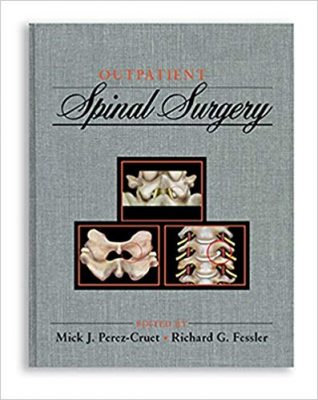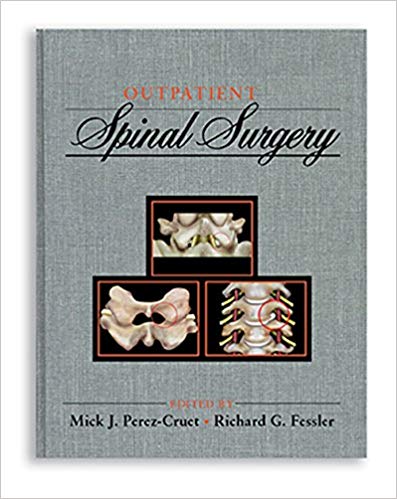 Editors: Mick J. Perez-Cruet, MD and Richard G. Fessler, MD
Editors: Mick J. Perez-Cruet, MD and Richard G. Fessler, MD
Publisher: Quality Medical Publishing – 311 pages
Book Review by: Nano Khilnani
Examining interior portions of a body through an orifice with the aid of a device (now known as an endoscope) without cutting into it was first done by the Arabian physician Albukasim (936-1013 AD, according to a Wikipedia article.
Much later, in 1807, Frankfurt-born Dr. Philip Bozzini used a lichtleiter (light conductor) to get brighter and clearer views of bone and the tissue inside his patients. Then, further developments by other medical pioneers enabled dissections and gave rise to what is today known as endoscopic surgery.
In 1977, M. Gazi Yasargil performed the first microsurgical operation on a herniated lumbar disc. Currently, minimally-invasive arthroscopic and endoscopic examinations and surgeries with illumination and magnification are common procedures performed in a variety of situations, including treating spinal disorders such as removing diseased or infected anatomic elements.
Such tasks can now be done when viewed not only dorsally but also laterally, medially and ventrally, and “performing surgery through a cannula that separates the tissue rather than severing it has been shown to reduce the postoperative morbidity and recuperation,” writes Dr. Parviz Kambin in his Foreword. He is professor of orthopedic surgery at MCP Hahneman School of Medicine in Philadelphia.
The focus of this book is on minimally invasive spinal surgical procedures, referred to in short as MISS. These procedures minimize operative trauma, write the editors of this book Drs. Mick Perez-Cruet and Richard Fessler in the Preface. The techniques used also minimize the destruction of bone, ligaments and muscles, relieve patients of much pain, and enable them to return to their daily activities in fairly short periods of time.
The rapid growth and improvement in MISS procedures has led to outpatient spinal surgery. Thirty-four specialists in neurosurgery (sometimes termed neurological surgery), neuroresearch, cerebrovascular and skull base surgery, spine care and related fields, mainly from the United States, as well as from Canada and Germany, authored or coauthored the 20 chapters of this book that we list below to provide you a broad overview of its coverage:
- Basic Considerations
- History and Overview
- Setting Up an Ambulatory Spinal Surgery Clinic
- The Business of Outpatient Spinal Surgery
- Patient Education
- Anesthesia and Pain Management
- Operative Procedures
- Posterior Cervical Microendoscopic Foraminotomy
- Anterior Cervical Foraminotomy
- Single-Level Anterior Cervical Microdiscectomy
- Anterior Cervical Spine Spacer
- Lumbar Microdiscectomy
- Microdiscectomy With Minimally Invasive Tubular Retractor
- Endoscopic Lumbar Microdiscectomy
- Endoscopic Far-Lateral Lumbar Microdiscectomy
- Endoscopic Lumbar Laminotomy for Stenosis
- Percutaneous Lumbar Techniques
- Vertebroplasty
- Minimally Invasive Lumbar Intervertebral Disc Stabilization
- Laparoscopic Anterior Interbody Fusion of the Lumbosacral Spine
- Complications and Outcomes Analysis
- Prevention and Management of Complications
- Clinical Outcomes Analysis
This textbook describes various operative techniques that are available today to spinal surgeons who perform same-day surgery. It also provides the experience and insight of prominent spinal surgeons on certain procedures, as well as information in studies on outcomes. Some of those operations pertain for example to:
- Mechanical posterior quadrant nuclear resection
- Significance of the epidural venous system in the development of lumbar radiculopathy
- Simple blind nuclear de-bulking procedures via chemonucleolysis
- Subligamentous arthroscopic access to a contained or non-migrated sequestrated herniated disc
- Transforaminal access for the retrieval of intracanalicular disc fragments
There are only just a few books available on the market on the subject of outpatient spinal surgery, so the authors and editors of this work not only fill a much-needed gap, but have done it quite well. The coverage of this book is quite extensive and detailed, so it would be a valuable addition to the library of aspiring and established spinal surgeons.
Editors:
Mick J. Perez-Cruet, MD, MSc. is a Clinical Instructor in the Department of Neurosurgery, at Rush-Presbyterian-St. Luke’s Medical Center, and Fellow at the Institute for Spine Care, Chicago Institute for Neurosurgery and Neuroresearch in Chicago, Illinois; formerly Vice Chairman, of the Department of Neurosurgery, Director of Spinal Research at Wilford Hall Medical Center at Lackland Air Force Base; and Clinical Assistant Professor in the Department of Neurosurgery at the University of Texas Health Science Center in San Antonio, Texas.
Richard G. Fessler, MD, PhD is Director of the Institute for Spine Care at the Chicago Institute of Neurosurgery and Neuroresearch, and Professor in the Department of Neurological Surgery at Rush-Presbyterian-St. Luke’s Medical Center in Chicago, Illinois.







